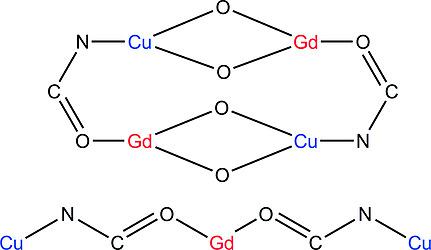当前位置:
X-MOL 学术
›
Eur. J. Inorg. Chem.
›
论文详情
Our official English website, www.x-mol.net, welcomes your
feedback! (Note: you will need to create a separate account there.)
Role of the Main and Auxiliary Ligands in the Nuclearity of Cu‐Ln Complexes
European Journal of Inorganic Chemistry ( IF 2.2 ) Pub Date : 2020-01-21 , DOI: 10.1002/ejic.201901150 Jean-Pierre Costes 1 , Maria-Jesus Rodriguez Douton 2 , Sergiu Shova 3 , Laure Vendier 1
European Journal of Inorganic Chemistry ( IF 2.2 ) Pub Date : 2020-01-21 , DOI: 10.1002/ejic.201901150 Jean-Pierre Costes 1 , Maria-Jesus Rodriguez Douton 2 , Sergiu Shova 3 , Laure Vendier 1
Affiliation

|
Trianionic ligands with an inner N2O2, an outer O2O2 or O2O coordination site and an oxygen atom coming from an amide function not involved in these sites yield dinuclear Cu‐Ln complexes that self‐assemble into tetranuclear species with an alternate arrangement of Cu and Ln ions. This alternate Cu‐Gd arrangement impedes Cu–Cu and Gd‐Gd interactions that could be antiferromagnetic and favours ferromagnetic Cu‐Gd interactions whose strength depends on the nature of the bridge, the phenoxo bridge made of a single oxygen atom or the amidato bridge made of three NCO atoms. Depending on the ligands, the phenoxo bridges can be single (CuOGd) or double (CuO2Gd), while the amidato bridge is always a single (CuNCOGd) bridge. A particular complex involving a trinuclear Cu‐Gd‐Cu arrangement through two amidato bridges confirms that the Cu‐Gd interaction through the amidato bridge is always weaker than the interaction through the phenoxo bridge. It has been possible to obtain complexes with an alternate Cu‐Gd arrangement involving more than two Cu‐Gd entities when two amidato bridges are present. These two amidato bridges may come from a main ligand, as in the case of tetraanionic ligands possessing two amide functions, or from two different ligands involving one amide function that are assembled by a Gd ion through their phenoxo functions. Note that the presence of auxiliary ligands with a good chelating ability for the Gd ion, such as the diketonato ligands, allows isolation of tetranuclear species only, regardless of the number of amide functions.
中文翻译:

主配体和辅助配体在Cu-Ln配合物核中的作用
具有内部N 2 O 2,外部O 2 O 2或O 2 O配位点和来自酰胺功能的氧原子(不参与这些位点)的三阴离子配体产生双核Cu-Ln络合物,其自组装为四核物质Cu和Ln离子的另一种排列方式。这种交替的Cu-Gd排列阻碍了可能反铁磁性的Cu-Cu和Gd-Gd相互作用,并有利于铁磁性Cu-Gd相互作用,其强度取决于电桥的性质,由单个氧原子制成的苯氧基桥或所制造的酰胺桥。三个NCO原子。根据不同的配体,苯氧基桥可以是单(CuOGd)或双(CuO 2Gd),而amidato桥始终是单个(CuNCOGd)桥。涉及通过两个amidato桥的三核Cu-Gd-Cu排列的特殊复合物证实,通过amidato桥的Cu-Gd相互作用始终弱于通过phenoxo桥的相互作用。当存在两个酰胺桥时,可以使用涉及两个以上Cu-Gd实体的备用Cu-Gd排列获得配合物。这两个酰胺基桥可以来自主要配体,例如具有两个酰胺官能团的四阴离子配体,也可以来自两个不同的涉及一个酰胺官能团的配体,它们通过Gd离子通过其苯氧羰基官能团组装而成。请注意,对Gd离子具有良好螯合能力的辅助配体(如二酮酮配体)只能分离出四核物质,
更新日期:2020-01-22
中文翻译:

主配体和辅助配体在Cu-Ln配合物核中的作用
具有内部N 2 O 2,外部O 2 O 2或O 2 O配位点和来自酰胺功能的氧原子(不参与这些位点)的三阴离子配体产生双核Cu-Ln络合物,其自组装为四核物质Cu和Ln离子的另一种排列方式。这种交替的Cu-Gd排列阻碍了可能反铁磁性的Cu-Cu和Gd-Gd相互作用,并有利于铁磁性Cu-Gd相互作用,其强度取决于电桥的性质,由单个氧原子制成的苯氧基桥或所制造的酰胺桥。三个NCO原子。根据不同的配体,苯氧基桥可以是单(CuOGd)或双(CuO 2Gd),而amidato桥始终是单个(CuNCOGd)桥。涉及通过两个amidato桥的三核Cu-Gd-Cu排列的特殊复合物证实,通过amidato桥的Cu-Gd相互作用始终弱于通过phenoxo桥的相互作用。当存在两个酰胺桥时,可以使用涉及两个以上Cu-Gd实体的备用Cu-Gd排列获得配合物。这两个酰胺基桥可以来自主要配体,例如具有两个酰胺官能团的四阴离子配体,也可以来自两个不同的涉及一个酰胺官能团的配体,它们通过Gd离子通过其苯氧羰基官能团组装而成。请注意,对Gd离子具有良好螯合能力的辅助配体(如二酮酮配体)只能分离出四核物质,











































 京公网安备 11010802027423号
京公网安备 11010802027423号